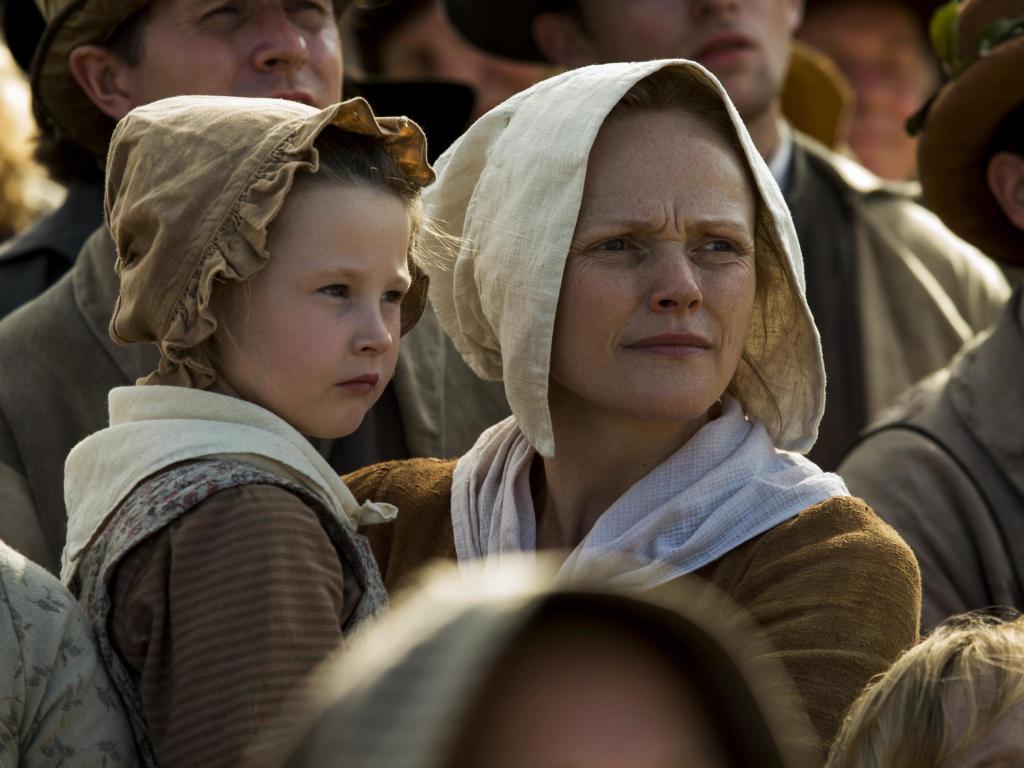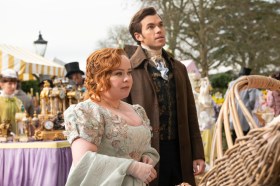Image: Peterloo. Source: Transmission.
One of my favourite moments of British cinema occurs in – of all things – Michael Winner’s A Chorus of Disapproval (1989). In it, Anthony Hopkins incarnates “Dafydd Ap Llewellyn”, the earnest, nerdy director of an amateur theatrical production of John Gay’s The Beggar’s Opera. At one point, Dafydd goes into promotional mode: “This opera is as relevant today as it was in 1728!” There’s something in the way Hopkins utters that line which tells you exactly the opposite – that this ancient theatrical relic is not, in the slightest degree, at all relevant to the modern world.
This fine moment of comedy returned to me while I watched Mike Leigh’s Peterloo, as well as later, when I scanned many respectful reviews of it. Almost to the last man and woman, these critics began their account of the film with a strident declaration of its searing relevance: it “speaks to today”, “can teach us much about our country [i.e., the UK] today”, is a “story that needs to be heard right now”. Someone even goes so far as to claim it “might as well be happening right now” (thank you, Rolling Stone). In my head, I hear Anthony Hopkins’ nervous, whining “oversell” uttering these pull-quotes.
Don’t get me wrong: the Peterloo Massacre of 1819, in which cavalry were ordered to charge into the vast crowd at a peaceful political rally in St. Peter’s Field, killing 18 people and wounding hundreds, is certainly a story worth telling – today, or any day. Leigh has expressed his intention to unearth and publicise a lesser-known – perhaps ruthlessly suppressed or downplayed – episode in British history. All well and good. But as for seeing in the finished film a salutary mirror for every problem in 21st century UK from Brexit and financial collapse to youth discontent and the rise of neo-conservatism – that is just too much “social reflection” for one pretty weak movie to bear.
It should come as a surprise to no one that, in Peterloo, the ordinary workers are shown as downtrodden and disadvantaged, while the ruling class (magistrates, politicians, factory or land owners) is comprised of grotesquely posturing blowhards and braggards. Some of the “portraiture” here is as extravagantly caricatural and over-the-top as in Yorgos Lanthimos’ The Favourite – but without a corresponding system of total stylisation at all levels of design, costume and camerawork. Leigh, as has often been the case since Bleak Moments in 1971, strands himself between a uniformly grey naturalism on the one hand, and a vaguely “Brechtian”, self-conscious artifice, especially popping out whenever he needs to dramatise the high offices of political power.
In overwrought chamber pieces like Secrets and Lies (1996) or Vera Drake (2004), Leigh has long been able to take cover under the spurious claim that he makes films in order to grandly “raise questions” and prompt public discussion. In Peterloo, however, there are no longer even any questions raised: the thesis of class war is engraved in stone from the very first shot (a hapless, traumatised “everyman” on the battlefield of Waterloo) to the last (a funeral for that same Everyman). In between, the various historical factors – economic, constitutional, political, international – that inevitably led to the Peterloo catastrophe are laid out and explicated in often clumsily scripted dialogues and monologues. We even get, right before the end, a “Eureka!” moment of revelation between two heroic journalists leaving the scene of the crime: “A Waterloo on St. Peter’s Field … the Battle of Peter’s Field … Peterloo … The Battle of Peterloo … No, the massacre! The Massacre of Peterloo, we must print that”. Mass media comes to the rescue of the working classes! Now, there’s a myth for you.
At punctual points, Leigh tries to sprinkle a little complexity – rather in the fashion of a school play or staged debate in which “both sides of every argument” are duly and schematically represented. Some details register sharply: the fact that, for instance, in St. Peter’s Field, many in the labouring mass who attended could probably neither see nor hear those speaking on stage. But, generally, the attempts at dramatic three-dimensionality are as hollow and predictable as everything else on show.
Here’s Leigh’s idea of complexity, in a nutshell: every group of citizens, whatever their class, harbours obedient sheep, recalcitrant throwbacks and raving fanatics. So Peterloo whacks us over the head with the recurrent presence of conservative women who fiercely (their faces set in an angry grimace) resist the burgeoning program of feminist suffrage; family members who express their sarcastic reserve concerning a workers’ movement that is “all talk and no action”, and thus puts no food on the table; and radical leaders of the people who are just a bit too radical and extreme – foaming at the mouth like rabid dogs as they explode, at rallies, with hate-speech and incitements to anarchic destruction.
Peterloo can be summed up by two “touches” dwelling at its perfectly Manichean extremes. At one end, the intoxicated Man of the Crowd who mechanically yells “Aye!” after every rhetorical proposal for change or revolution; and at the other, the dandy-ish figure of reformist Henry Hunt (Rory Kinnear) in white suit and hat, shunning the workers on a personal level while speaking in their name, impatiently sitting for a portrait in the unsalubrious surroundings of an ordinary home and demanding a “light repast” from whichever womenfolk are passing through the room at the time.
It’s a long, slow burn (two and a quarter hours, in fact) to the big moment – the Peterloo massacre itself. The Guardian film critic Peter Bradshaw described this climactic scene as a set-piece in which Leigh “lets rip”, creating an “impressive” and “immersive” experience. He concludes, rather stiltedly: “David Lean might have been proud to have shot the sequence”. And then again, he might not have! Reading this, I had to wonder whether Bradshaw and I had seen the same film. No one is asking Leigh, in this context, to make a Michael Bay-style ode (impressive and immersive!) to carnage and bloodshed. However, if we are going to evoke the great battle scenes in Lean’s Lawrence of Arabia, Eisenstein’s Battleship Potemkin or Welles’ Chimes at Midnight, we would expect more than the dreary, monotonously staged vignettes here, with most signs of violence discreetly minimised while men on horses wade into the crowd in long shot, and Dick Pope’s camera (he’s both DOP and operator) stays positioned at a slightly elevated angle, as if in fear of seeming too “vulgarly” involved in the event it shows. Whichever way you slice it, this is among the worst directed action scenes in cinema history.
It’s worth taking a closer look at Leigh’s manner of directing both his actors and the camera (let’s mercifully leave aside the functionally bland music score for Peterloo, for which Gary Yershon has seemingly been asked to mainly plug a few holes on the soundtrack and smooth over the scene transitions). Among the most basic tools in any filmmaker’s kit is the “match on action” – joining two shots by editing on some gesture or movement that overlaps them. In Hollywood’s classic period, directors realised that this was not merely a way of preserving scene continuity, but more deeply, a richly expressive technique. The actors’ gestures were limited and concentrated – such as raising a head at the end of a line of dialogue, or turning the body to mark a “beat” in the action – and the editing followed suit, underlining the meaningful dynamics of events. It’s precisely this kind of filmmaking “syntax” or system that made (for example) Robert Mitchum such a powerfully cinematic star presence.
There aren’t many “match cuts” in Leigh’s films. He doesn’t conceive of shot progressions in that kinetic way; moreover – and most damagingly – he directs his actors in a manner that nullifies any possibility of it. Much has been made, down the years, of Leigh’s lengthy, improvisational “workshopping” with his actors before the shoot begins – imagining scenes and interactions that are not in the script. This process may well help the players inhabit their parts; but it leads to performances that mesh with nothing but the dullest and most plodding procedures of mise en scène.
Leigh’s actors develop ultra-psychological character “tics” – like looking furtively in every direction, or lowering then lifting their head and eyes – which they repeat over and over in a loop, as the camera rolls. (There is always a prize ham in any Leigh ensemble, and here – in the absence of the usual Timothy Spall – the award goes to Vincent Franklin as Reverend Charles Wicksteed Ethelston.) Where the cut comes is often a matter of little consequence; each shot states – or overstates – its point and purpose, then hangs around on screen until the next one begins, arbitrarily.
In my opinion, it’s not a good model for cinema – especially in Australia, where Leigh has found some of his most faithful supporters among filmgoers and filmmakers alike. The revolution – for better cinema – must begin here!
| 1 star |
★
|
© Adrian Martin, May 2019
Peterloo
Director: Mike Leigh
UK / 2019 / 2h 34m
Rating: M
Distributor: Transmission
Actors:
Director:
Format:
Country:
Release:





